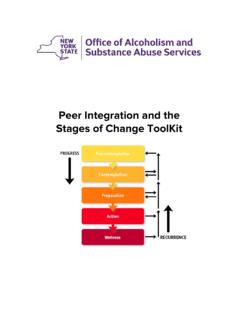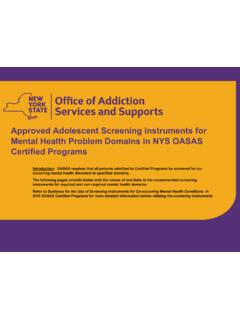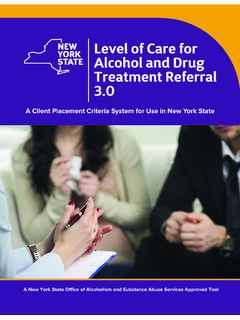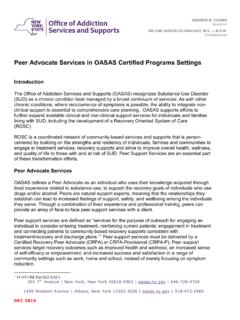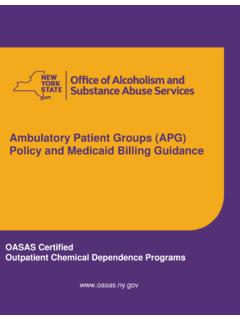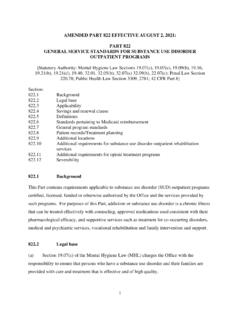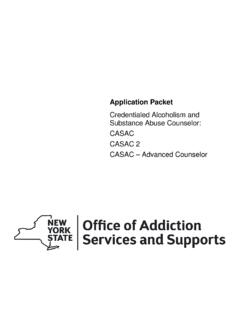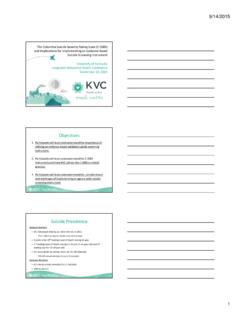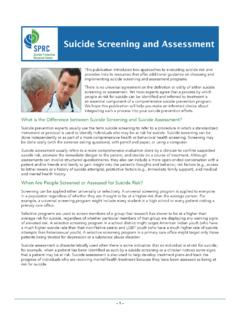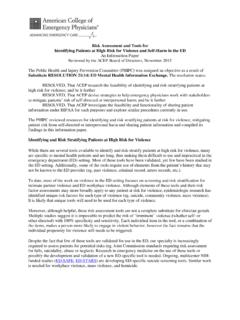Transcription of SCREENING FOR CO-OCCURRING DISORDERS USING THE
1 SCREENING FOR CO-OCCURRING DISORDERS USING THE. MODIFIED MINI SCREEN (MMS). USER'S GUIDE. (Rev. 6/05). ACKNOWLEDGEMENTS. This user guide was developed by the NYS Practice Improvement Collaborative (PIC) under a grant from the Department of Health and Human Services, Substance Abuse and Mental Health Services Administration, Center for Substance Abuse Treatment. It was compiled by PIC Project Director Susan Brandau, in collaboration with the NKI Research team, specifically Mary Jane Alexander and Gary Haugland. We are grateful for suggestions received from pilot trainees that were ultimately incorporated into the document. Some of the content for this manual was adapted from the following sources: Summary of the California Board of Corrections Mentally Ill Offender Crime Reduction Grant Project Manager's Meeting presentation conducted by Roger H. Peters, PhD and Richard K. Sherman, MS, October 4, 2001. The Modified Mini Screen (MMS) is a 22 item scale designed to identify persons in need of an assessment in the domains of Mood DISORDERS , Anxiety DISORDERS and Psychotic DISORDERS .
2 The questions are based on gateway questions and threshold criteria found in the Diagnostic and Statistical Manual IV (DSM-IV)1, the Structured Clinical Interview for Diagnosis (SCID)2 and the Mini International Neuropsychiatric Interview ( )3. 2. WHAT ARE CO-OCCURRING DISORDERS ? A person who has alcohol or drug abuse/dependence and emotional/psychiatric problems is said to have CO-OCCURRING DISORDERS . To recover fully, treatment is required for both problems. HOW PREVALENT ARE CO-OCCURRING DISORDERS ? According to a face-to-face survey of people in randomly sampled households across the , thirty-seven percent of alcohol abusers and fifty-three percent of drug abusers also have at least one mental disorder. According to the National Household Survey on Drug Abuse, within the diagnosed mentally ill population, twenty percent currently abuse either alcohol or drugs and sixty percent will have abused either substance during their lifetime. Individuals with mental DISORDERS are at increased risk for developing a substance abuse disorder and conversely, people with substance abuse DISORDERS are at increased risk for developing a mental disorder.
3 WHAT TYPES OF MENTAL OR EMOTIONAL PROBLEMS. ARE SEEN WITH PEOPLE WITH CO-OCCURRING . DISORDERS ? Psychiatric problems commonly found in persons with CO-OCCURRING DISORDERS can be arranged under four main categories: Mood DISORDERS are characterized by extreme emotions such as major depression, bipolar disorder (formerly called manic-depression) and dysthymia (a milder but chronic form of depression). Anxiety DISORDERS are characterized by powerful fears and avoidance behaviors. They include Post Traumatic Stress Disorder; Obsessive- Compulsive Disorder (obsession are unavoidable thoughts and compulsions are unavoidable behaviors); Social Phobias ( , excessive shyness); Agoraphobia (fear of being in crowds or places with no easy exit); Panic Attacks; and generalized, non-specific anxieties. 3. Psychotic DISORDERS include severe illnesses such as schizophrenia. These DISORDERS are characterized by unusual thoughts and beliefs, often at odds with evidence apparent to others and the behaviors that result from acting on those ideas.
4 Visual or auditory hallucinations, extreme paranoia and delusional thoughts may be present. Personality DISORDERS are characterized by enduring and inflexible patterns of experience and behavior, across a broad range of personal and social situations, that markedly differ from the expectations of a person's culture, and that lead to either significant distress or impaired function in important life domains. (Personality disorder items are not included in the Modified Mini Screen.). WHAT ARE THE GENERAL CHARACTERISTICS OF. PATIENTS WITH CO-OCCURRING DISORDERS ? Substance abuse and mental DISORDERS have biological, psychological, and social components, so people with CO-OCCURRING DISORDERS have disabilities, disadvantages, and psychosocial problems that interact with each other. CO-OCCURRING DISORDERS occur across the lifespan in both men and women. When one or both DISORDERS are severe, consequences include inability to maintain stable housing or to stay employed, repeated cycles through treatment, probation, jail, or prison.
5 Use of even small amounts of alcohol or drugs may trigger recurrence of mental health symptoms. WHAT ARE THE TREATMENT RELATED. CHARACTERISTICS OF A PATIENT WITH CO-OCCURRING . DISORDERS ? Patients with one or more severe CO-OCCURRING DISORDERS are likely to use services only when in crisis, to be minimally engaged in treatment, and to be involved with the criminal justice system. Some specific characteristics are: More rapid progression from initial use to substance dependence Poor adherence to medication Decreased likelihood of treatment compliance Greater rates of hospitalization More frequent suicidal behavior especially for clients with schizophrenia spectrum, major depressive or bipolar DISORDERS . Fifteen to 25% of suicides 4. are committed by persons who abuse alcohol. Suicide may also be associated with intoxication or withdrawal from addictive substances. Difficulties in social functioning Shorter time in remission of symptoms In addition, individuals with severe DISORDERS are: More sensitive to substance effects Unlikely to develop dependence or medical signs of sustained, heavy use More likely to encounter substances and pressure to use More likely to experience negative outcomes WHAT ARE THE BEHAVIORAL CHARACTERISTICS OF.
6 PATIENTS WITH CO-OCCURRING DISORDERS ? People with mental DISORDERS will have the characteristics of the disorder they suffer from. Those with severe mental illness may have: Difficulty comprehending or remembering important information Inability to recognize the consequences of behavior, thereby affecting the ability to plan Poor judgment Disorganization Limited attention span Poor response to confrontation They are likely to use substances to: Combat loneliness, social anxiety, boredom, insomnia Deal with stress or strong emotions like anger, pain, shame, guilt Relieve specific symptoms of mental illness or medication side effects WHAT BENEFITS ARE ASSOCIATED WITH RECOVERY FOR. PATIENTS WITH CO-OCCURRING DISORDERS ? Regular engagement in enjoyable activity Decent, stable housing Loving relationships with someone sober who accepts person's mental illness Positive, valued relationship with treatment professional When actively engaged in treatment, clients with CO-OCCURRING DISORDERS are actually more likely to attend outpatient groups 5.
7 WHAT IS THE PURPOSE OF SCREENING FOR CO- occurring DISORDERS ? The purpose of a SCREENING instrument such as the Modified Mini Screen in chemical dependency treatment settings is to identify patients with a high likelihood of having a mental illness that could compromise successful treatment outcomes. A high screen score will prompt a referral for a more thorough psychiatric assessment. SCREENING should be completed in a timely manner to assist in developing a comprehensive treatment plan, as required by OASAS Chemical Dependency Regulations. It should be noted that SCREENING is a process for evaluating the possible presence of a problem while assessment is a process for defining the nature of that problem and developing specific treatment recommendations to address that problem. While SCREENING can be conducted by any trained clinician, assessments can only be conducted by licensed practitioners. High prevalence, low treatment and low engagement rates, as well as the under identification of CO-OCCURRING DISORDERS in treatment settings highlight the need for better detection and assessment procedures.
8 Treatment outcomes have been poor for chemical dependency clients who have mental DISORDERS . The absence of assessment of CO-OCCURRING DISORDERS has been identified as a major barrier to effective treatment and prevention. The SCREENING process allows a clinician to assess whether there are signs that a patient with a substance abuse disorder has a mental disorder as well. If a problem is identified, the patient should be referred for a more detailed assessment and an appropriate referral. Adequate assessment of the full picture of a patient's co- occurring disorder occurs over time in an established trusting relationship with a skilled clinician. SCREENING for mental DISORDERS is the first step in good clinical practice for patients with CO-OCCURRING DISORDERS . SCREENING demonstrates to the patient that the program is committed to identifying and addressing the full range of their problems. The therapeutic relationship is initiated when these problems are brought out into the open and treatment options and limits are discussed in a context of respect and acceptance.
9 WHEN SHOULD SCREENING OCCUR? Alcohol and substance abuse greatly influence symptoms of mental illness, and vice versa. Abuse of addictive substances like alcohol, opiates, and cocaine may precipitate mental DISORDERS like depression and psychotic DISORDERS are 6. sometimes secondary to use of crack cocaine, hallucinogens, alcohol, and ecstasy. On the other hand, withdrawal from substances may exacerbate symptoms of mental DISORDERS when substance use has been a way for the person to cope with depression, loneliness, boredom, or anxiety. When both DISORDERS are identified, they should be considered as primary and should be treated. In addition, HIV and Hep-C positive patients may exhibit symptoms, such as dementia, due to the disease itself or the medication regimen. Substance related affective symptoms (depression, mania) usually clear within two weeks of abstinence; psychotic symptoms usually clear within days to a week of abstinence while symptoms of anxiety may take up to six months to clear.
10 Administration of the Modified Mini Screen after two weeks of abstinence is recommended. The goal is to screen the patient when their sensorium is not clouded by alcohol or other drugs and/or the withdrawal of substances at a minimum, the patient should be stabilized prior to SCREENING . Thereafter, a clinician may conduct subsequent screens as appropriate based upon their clinical judgment and as per the program's policies and procedures. CLINICAL OBSERVATIONS BY STAFF SHOULD NEVER BE. REPLACED BY ANY SCREENING TOOL. It is the program's responsibility to develop a written implementation plan that identifies the specific SCREENING procedures that the provider will adhere to. A suggested implementation guide has been developed to assist in this process which identifies a range of issues relative to implementation. HOW ACCURATE IS SCREENING ? Screens are first line identifiers and as such, are imperfect. They may either under identify or over identify the condition they are designed to detect.
